K+2P versus K+P - Protected passed pawn - Part III (in progress)
With a rook pawn the position favors always the stronger side.
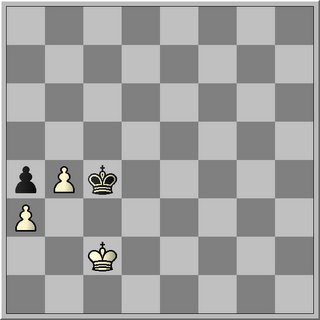
The critical squares of white's rear pawn (green rectangle) falls within the square of the protected passed pawn (blue).In comparison to the position, moved up one rank black has gained in territory. So his king is less restricted. Alas, to no
Again both mechanism described for the rook pawn on the fifth rank can be applied. White does not have to worry about the counter attack against his rear pawn as the resulted Queen versus pawn ending is a loss. The attack against the rear pawn can be an interesting defense for black when he has a bishop pawn.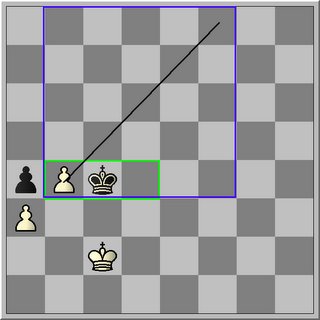
So the first mechanism - kingside invasion by using your space advantage.
I have not been very precise on the term Kingside and Q-side. So let us define what I mean with it. Kingside and Q-side does not necessarily refers to the division on the chess board to the right or to the left half of the board. It may coincide. I use the term as follow. I use King and Q-side in reference to the blocked pawn stellation. So a blocked rook pawn on the a-file with a protected passed b-pawn has only a K-side and no Q-side although the pawns are on the Q-side of the board.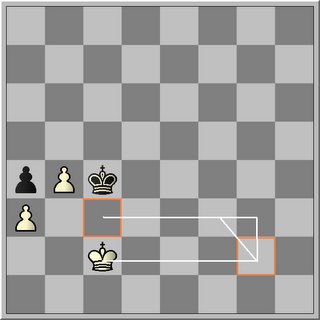
In orange you can easily see white's target squares to put black in zugzwang. Notice that I did not highlighted black's path. White is not really interested in what black's answer is. His best defense is to maintain the direct opposition as long as he can to prevent white of going up one rank. Only when white has reached the orange target square the reply of black becomes more or less interesting as a wrong move might prolong the defense of black. No worries just go back to the orange square and try again.
So in the starting position white does not have the opposition. To invade the king needs to be in opposition & a space availability of at least three files or ranks. To gain the opposition white goes through a non-corresponding square for black. This last point is vital as the implication is more far reaching than the above example shows with two kings in direct opposition. In fact it shows you the basic method to win in any king position with this pawn configuration. Remember the black king is a sitting dead duck.
Let us first look to the second mechanism before we go into digging out the above statement.
So the second mechanism - X-cross method.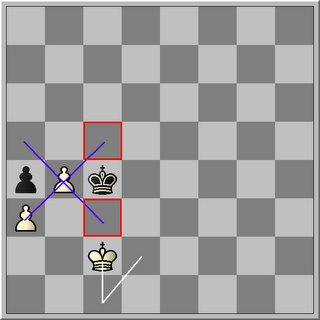
In this method white notice that black cannot maintain the direct or distant opposition as both squares (c3 & c5) are not accessible to the black king. White make use of the restricted mobility of black in that area of the board to gain the opposition. By gaining the opposition white can invade black's position and can move up one rank. By moving up one rank (to the 3rd rank) black will be able to regain the opposition. To make progress to the next rank white can exploit the weakness on c5 by going to c3. Again black has no corresponding square and he will have to make way to white. White can move up one rank and reaches the critical squares to win the black pawn.
Here white used in the beginning the technique of triangulation to gain the opposition.
Let us consider the following position with as difference the relocation of both kings. It is white to move and black has the opposition.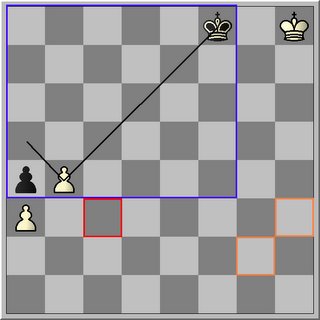
In orange you can see the squares where you can put the black king in zugzwang. The red rectangle is your final target square (remark lower square of the X-cross). When your king occupies the red square, you have reached the square where you can invade black's position.
For example the following play can happen.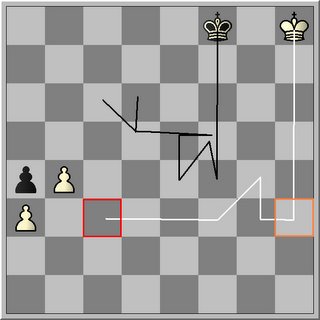
Because of the fact that black cannot counter attack against white's rear pawn, white has all the time to bring his king to the lower part of the X-cross. The same should hold true for a knight pawn (b-file) with an inward protected passed pawn. It is always a win for the stronger side.
With a pawn on the 4th rank and on the bishop file, one has to take the possibility of a counter-attack into mind. White cannot just go off and try a kingside invasion on the premisses of having the opposition.
Let us consider the following position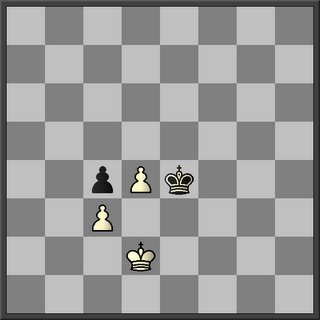
Notice in all other positions the stronger side had to win first the opposition before he could invade. Here we already grant white the opposition. His task should be considerably easier, although unthoughtful play might lead to a draw.
To invade white needs to have the opposition and space of at least three files broad. Black, however, cannot prevent this (invasion) of happening.
With the kings on the primary and black has the move he has either two choices:
either he allows white to take control of the lower-end square of the X, red square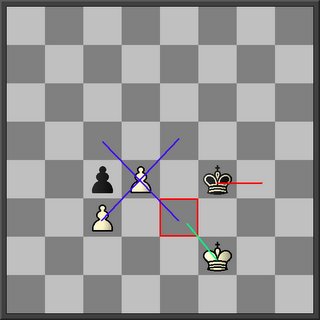
or he might try to prolong the fight by sealing of the critical square nearest to the pawn.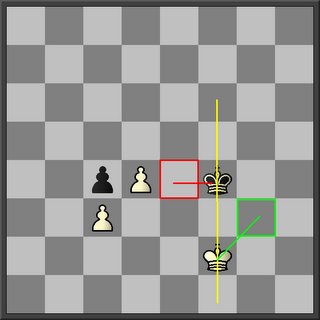
If white tries to outflank him on the kingside black (with a bishop pawn and an inward protected passed pawn) just encourages white to do so.
Why?
The kingside outflanking can only be applied in cases where the capture of the rear pawn by black makes no difference to the outcome of the game. Here, with an inward protected passed pawn white will be punished for its dareness as the resulting queen ending is a draw.
When white goes to g3 black will attack the rear pawn. White needs 4 moves to promote the pawn. Black needs 5 moves to bring the pawn to 2nd rank. But it is black's turn to play he has an extra tempo. Now the win or a draw will depend on the position of the white king.
1.Ke2 Kf4 2.Kf2 Ke4 3.Kg3 Kd3 4.d5 Kxc3 5.d6 Kb2 6.d7 c3 7.d8Q c2 (=)
In the Queen ending white can only win if his king is within the blue area. This means that the white king is near enough to allow a direct capture of the pawn or that black will be mated after the pawn Qeens.
If White's king is too far off (out of the blue area) than black can draw by going to the corner as the capture of the pawn by the queen will stalemates the black king.
Notice the inward protected passed pawn shows already on which side the black king will move (opposite of the promoting pawn) to prevent a check by promotion of the white pawn to a queen.
So with a bishop pawn on the 4th rank and an inward protected passed pawn white cannot leave his rear pawn unprotected. To win he will use a different kind of set-up.
Let us have a closer look to the initial position.
Now we know if white's king would stand on e3 he would have a forced win. Now how can white accomplish that?
At first sight it seems that black has a good starting position to defend the e3 square. White cannot make progress even if he has the opposition. Therefore white will create a second weakness. If we consider e3 as a kingside invasion point than a4 should be the Q-side invasion point.
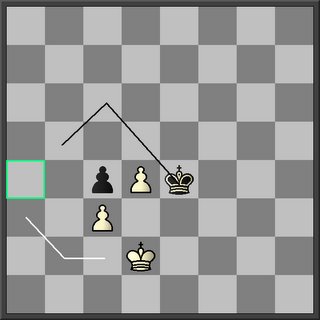
Remember a4 is a critical square of the c3 pawn. So white needs 4 moves to be on a4 and 3 moves to be on a3 (shortest path). Black can stop the invasion on the q-side by blocking the access to this square. Therefore he has only 3 moves at his disposal. At the 3rd move he can be on b5 preventing white reaching a4. So white might conclude that he can make no progress.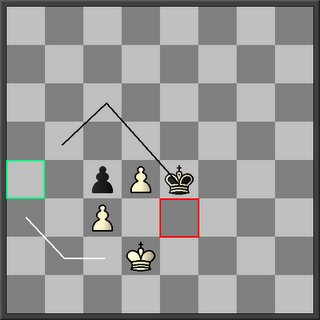
So we looked at the invasion points as two separate entities. We can draw between the two invasion points a path of minimal tempos for the black king but also for the white king. 
But white has more than one path while black has not. The orange squares shows you where white has a choice.
Black going from one side to the other is restricted to follow the line and cannot deviate from it as he is bound to follow the shortest path. If he dares to deviate he cannot be on time to defend both invasions points against white. White on the other hand has flexibility and can make a choice. He can even decide to prolong his path with one move, staying at the same distance of both invasion points. By doing this he will bring black into zugzwang and forcing him to make a choice. whatever choice he makes white will react by going to the other side and the intrusion cannot be prevented.
We come to the stunning conclusion that both kings have a different degree of flexibility concerning both invasion points. White has 2 paths of minimal tempo versus black, which has only one. This method might be interesting to figure out the corresponding squares. For corresponding squares I refer to temposchlucker's interesting post. (24 february 2006)
One note: if we consider the degrees of freedom (along the paths) from left to right for the white king we see the following pattern 1-1-2-1. For the black king we obtain the following pattern going from left to right 1-1-1-1. Black could have hold the draw if his pattern was 1-1-2-1 but the pawn formation does not allow this. His second square is where the pawn is standing on d4. So we have a symmetrical pattern shifted with one file-move versus each other.
No in the language of triangulation (through the orange squares) this is an example where the king has been placed into zugzwang.
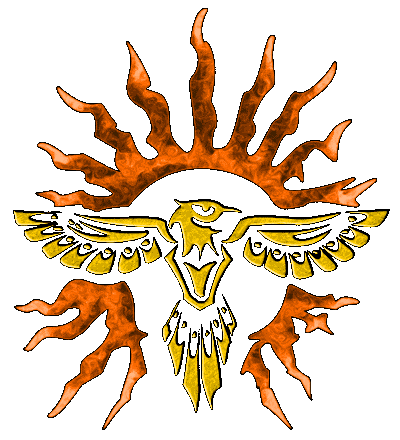

2 Comments:
if quality was the primary determinant in how many comments a person gets, then you aught to be a chess blogspot leader. so what exogenous factors dirve the wheel?
no, it is not to syncophantic, but simple appreciation.
Well, first of all it is a good rehearsal for myself. By compiling the information it is much easier to remember and also much easier to study. Seeing train tables in a book and trying to gather all information around an item is primarly hard labour and for some people not quite stimulating. I believe by picturing these train tables you will engrave it in your memory much faster. You might know something now but will you remember it 2 months later with all the finesses when you are looking at your train tables. I doubt it unless you were able to practice the new knowledge profoundly. How many endgame books are there on the market handling these questions only by showing one or two positions. They fail because they are to summier, they do not give all possible defenses or attacks etc. So you can buy dozen of books and still miss half of the information around a simple position. If the published books represents the knowledge of chess authors and how they handle chess subjects I would recommend almost no one. The books are written economically with an emphasis on touching a subject and not explaining the whole picture. I like to visualize things so I use a lot of diagrams to get an overview.
I full agree what BDK has to say about it
Montse: this is very helpful stuff. I have been reading about Lucina/Philidor and it is exactly as you say: all the books give one position to try to make a general claim. It seems chess authors are a lazy bunch: they could do so much more. The job of a good author is to minimize the amount of work you have to put in to understand what they've done. It is clear that many chess authors don't do that (note this doesn't mean we shouldn't have to work ourselves to understand the positions, etc., but come on).
My view: The books written are not really meant to educate profoundly.
Every course like for instance in chemistry or maths can be teached in a simple or in difficult to understand way. It is up to the teacher. The same can be said about chess books. It can be considered as summarized versions of their own thoughts about a certain topic. Not complete, just an introduction like you get only half of the integrals formules to solve the equations. Very uncivilized I would say. So I enjoy the fact that I can still found new things not written (not I am aware of). How many books are handling corresponding squares although I am sure experts are longing for such a knowledge. Instead you get primarly books about openings, openings, and openings althoug every master will tell you that openings is not so important. So there is a dicrepancy between what they are telling and what the public gets.
My tought an average person can become a master or civil engineer only he should be educated in a proper way. Some will need more care than others, but if they will is present success will eventually follow
Post a Comment
<< Home